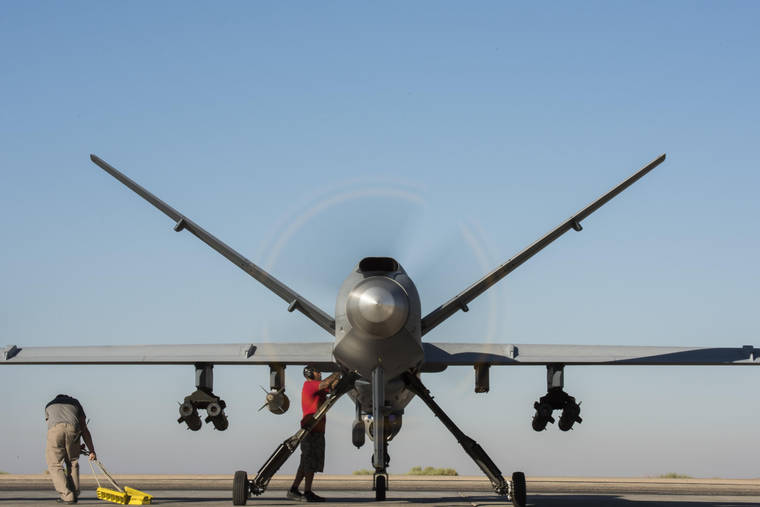Reaper Killer drones to be based on Oahu at Kaneohe Marine Corps base
Published by jalbertini on March 27th, 2021 in Military, Pohakuloa, Radiation, Social Justice, Take Action!.
6 Reaper drones will be based on Oahu
- By William Cole
- March 24, 2021
-

U.S. AIR FORCE PHOTO BY SENIOR AIRMAN DAMON KASBERG
The Marine Corps in Hawaii will be getting six big MQ-9A Reaper drones that can be armed with missiles as the Corps as a whole pursues “a deliberate but aggressive” path toward unmanned systems to gain advantage over China.
“Today’s global security environment has seen a return to great power competition,” the Navy and Marine Corps said in a new “Unmanned Campaign Framework.” “This shift has placed the Department of the Navy at an inflection point where a traditional force structure will not be enough in the face of new warfighting demands.”
Maj. Joshua Benson, a Marine Corps spokesman, said the six Reapers will arrive in Hawaii beginning in fiscal 2023 and fall under the already existing Marine Unmanned Aerial Vehicle Squadron 3, or VMU-3, which operates much smaller RQ-21A Blackjack drones.
The addition of Reapers is just one of several big changes coming to Marine Corps Base Hawaii as the entire Corps undergoes a radical reorganization designed in large part to counter China in the Western Pacific with fast-moving and distributed missile forces aided by unmanned ships, vehicles and aircraft.
Officials recently announced that three dozen or more helicopters — the entire Marine Corps fleet — will be departing Kaneohe Bay and a squadron of KC-130 cargo and refueling aircraft will be based in Hawaii in coming years.
The turboprop-powered Reaper, with a wingspan of 66 feet, a maximum takeoff weight of 10,500 pounds and a flight endurance of 34 hours for the “extended range” version, was first flown in 2001 and has been used by the Air Force in Iraq, Afghanistan, Syria and other locations worldwide.
The hunter-killer drone was designated “Reaper” by the U.S. and Royal Air Force, which has become the widely used name for any “Predator B” model equipped with weapons, according to maker General Atomics. The Reaper is bigger and heavier than the Predator.
Marine Corps MQ-9As would be the biggest military drones in Hawaii. By comparison, Army RQ-7B Shadows that have operated out of Wheeler Army Airfield have a 20-foot wingspan and 460-pound gross takeoff weight.
Unarmed Wheeler Shadows pair with AH-64 Apache helicopters as one example of Army force multiplication using an unmanned system.
The Hawaii-based Reapers, which will be operated by hundreds of Marine Corps personnel performing a range of jobs, could be armed with AGM-114 Hellfire missiles, officials said. The Air Force has used laser-guided bombs.
On March 16 the Navy and Marines released the “Unmanned Campaign Framework” in which acting Navy Secretary Thomas Harker said, “To compete and win in an era of great power competition, the (Navy) department is committed to investing in advanced autonomy, robust networks and unmanned systems” that will yield new capabilities extending “well beyond” human systems.
In the report, Marine Corps Commandant Gen. David Berger said he is committed to a “deliberate but aggressive” pathway toward unmanned systems.
“The campaign plan serves as a starting point for the Marine Corps to understand that unmanned systems must and will take on greater importance in our near future,” Berger said. “Concepts such as half of our aviation fleet being unmanned in the near- to mid-term, or most of our expeditionary logistics being unmanned in the near- to mid-term, should not frighten anyone.”
When operating forward in small groups under austere conditions, “the ability to maximize unmanned systems to create outsized effects for our allies and against our adversaries is a key element of our future success,” Berger wrote.
Unmanned systems are becoming so important that the U.S. Pacific fleet in April will conduct an “integrated fleet battle problem” that will incorporate unmanned systems operating in the air, on the surface and subsurface, according to the new report.
At a congressional hearing Thursday on unmanned Navy Department systems, Lt. Gen. Eric Smith, commander of Marine Corps Combat Development Command, said the Corps already operates two of the extended-range Reapers in the Middle East and will procure 16 more, for a total of 18.
The unmanned aircraft will be distributed into three squadrons of six, he said.
“The way that system operates is from a friendly base,” he said. “That could be the continental United States; it could be Guam; it could be Hawaii or a particular nation.”
In early 2020 the Navy deployed to Guam two turbofan-powered MQ-4C Tritons, unmanned aircraft with a 130-foot wingspan, to expand the reach of its maritime patrol and reconnaissance forces.
Smith also talked about the ROGUE (Remotely Operated Ground Unit Expeditionary) fires vehicle, which is a joint light tactical vehicle stripped of its crew cab and turned into a robotic vehicle.
“So it’s paired as a manned-unmanned teaming system,” he said. Some vehicles would be outfitted to fire Naval Strike Missiles and could autonomously follow a command vehicle. A ROGUE system successfully fired a missile in November, Smith said.
Louisiana-based shipbuilder Metal Shark was selected to develop a 45-foot “long range unmanned surface vessel” for the Corps, meanwhile.
“We did some testing at a classified level that explained how that, combined with the Naval Strike Missile, puts a very high-dollar, high-value enemy platform at risk,” Smith said.
The Navy’s Unmanned Campaign Framework noted that the MQ-25A Stingray will be the first aircraft carrier-based unmanned aircraft, functioning primarily as a refueling tanker.
Fabrication has begun on the Orca “extra large unmanned undersea vessel” with the first vehicle expected to be delivered in fiscal 2022. Other unmanned platforms are also in the works by the Navy and Marine Corps.
“Unmanned systems are truly disruptive — both for us and our adversaries,” the campaign plan states.
MQ-9A ‘Reaper’
Turboprop-powered, remotely piloted aircraft first flown in 2001
Wingspan: 66 feet Length: 36 feet
Armament: Hellfire missiles, laser-guided bombs
Maximum takeoff weight: 10,500 pounds
Payload: 850 pounds internal, 3,000 pounds external
Maximum altitude: 50,000 feet
Maximum endurance: 34 hours for extended-range version
Feed for this entry. Responses are currently closed, but you can trackback from your own site.
